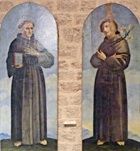

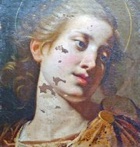
Head of a saint, attributed to Andrea Camassei
Pinacoteca, Bevagna
Andrea Camassei was born in Bevagna and maintained his links with the town throughout his life. His early influence seems to have been provided by Ascensidonio Spacca, il Fantino, who designated him as his heir in a will dated 1627.
Andrea Camassei is documented in Rome from 1626, when he worked under Domenico Zampieri, called Domenichino. He seems subsequently to have joined the more progressive workshop of Andrea Sacchi, and both men are documented as working under Pietro da Cortona in 1628 at Villa Sacchetti at Castel Fusano, near Ostia. He subsequently joined the movement against the exuberance of the style of Pietro d Cortona, which was led by Andrea Sacchi.
He is documented in 1631 at work in Palazzo Barberini, Rome, which marks the start of his important connections with this family and, in particular, with the Barberini Pope Urban VIII. He was active in the Academia di San Luca (the painters’ guild in Rome), and became the custodian of the Sistine Chapel in 1634. He was elected Consul in absentia in Bevagna for two months in 1632 and intervened on behalf of the town in 1634, when he prevailed upon Taddeo Barberini to intercede in a dispute that involved the stationing of papal troops there.
Like many Roman artists, Andrea Camassei suffered professionally when Urban VIII died in 1644, and was succeeded by his enemy, Pope Innocent X. He lost his position in the Sistine Chapel, and might have been imprisoned for a short period. He seems to have spent more time thereafter in Umbria, although he was documented in Rome at easter in each of the next five years. He died there in 1649 and was buried in Sant’ Agostino.
Bevagna
Works for SS Domenico e Giacomo
A fresco (1626) of a miracle of St Dominic, which was dated by inscription and attributed to Andrea Camassei, survived in the refectory of the ex-convent of SS Domenico e Giacomo until the 1960s. Three works from the church that are also attributed to him (see below) probably date to the same period:
-
✴the frescoed backdrop of the Miracles of San Domenico in Soriano, which survives in situ; and
-
✴panels of SS Joseph and Antony of Padua, which are now in the Pinacoteca.
The Commune paid him for three other altarpieces for the church in 1632, when the process for the canonisation of the Blessed James Bianconi was revived, but these have not survived.
Miracle of San Domenico in Soriano (ca. 1626)
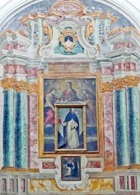
-
✴the copy of the miraculous image is attributed to Giovanni Battista Pacetti, called lo Sguazzino; and
-
✴the surrounding figures of the Virgin and SS Catherine of Alexandria and Mary Magdalene are attributed to Andrea Camassei.
SS Joseph and Antony of Padua (ca. 1626)

-
✴St Joseph holding the Virgin’s wedding ring and the staff that flowered in order to identify him as the chosen bridegroom.
-
✴St Antony holding his uncorrupted tongue (a relic venerated in Padua that symbolises his skill as a preacher) and an image of the baby Jesus, whom the Virgin passed to him in a vision.
Frescoes in San Michele (ca. 1625)
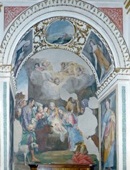
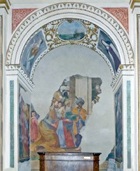
The Cappella della Madonna del Carmine of San Michele, which belonged to the Spetia family, was restored in 1607 and re- consecrated in 1625. Andrea Camassei executed its frescoes to considerable acclaim. They include the Nativity and the Adoration of the Magi (illustrated, respectively, to the left and right above).
Drawing of Mosaic (ca. 1630)
This drawing, which is now in the Royal Collection, Windsor Castle, constitutes the earliest surviving record of the mosaic of the Roman baths of Bevagna.
Works in Santa Margerita
The church of Santa Margherita contains a number of works that are attributed to Andrea Camassei, whose sister became a nun there in 1632:
-
✴The altarpiece (ca. 1627) in the Cappella di San Filippo Neri (on the right) depicts a vision of St Philip Neri and is surrounded by six scenes from his life. It was probably painted to celebrate the arrival of relics of St Philip Neri in the church. It is a copy of a work by Guido Reni in the Chiesa Nuova (the mother church of the Oratorians) in Rome.
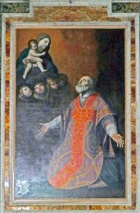
-
✴The altarpiece (ca. 1630) on the right wall depicts the Immaculate Virgin with SS Andrew, Vincent, Bonaventure and Nicholas of Tolentino. This altarpiece seems to have been taken to France in the Napoleonic period and later found its way to the church of San Nicolò, Foligno. It was returned to Santa Margherita in 1921.
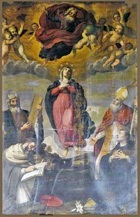
-
✴The altarpiece (ca. 1645) on the high altar depicts the martyrdom of St Margaret. It probably dates to the period after the renovation of the high altar in 1640 and perhaps after Andrea Camassei left Rome following the death of the Barberini Pope Urban VIII in 1644.
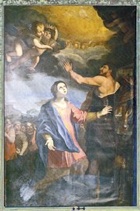
Other Works in the Pinacoteca
The Pinacoteca contains the following works by or attributed to Andrea Camassei:
Head of a saint (17th century)
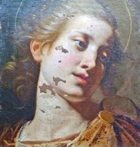
St Sebastian (17th century)

SS Charles Borromeo and Philip Neri (17th century)
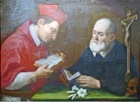
Foligno
Annunciation (1626)
The noted scholar, Ludovico Jacobili commissioned this altarpiece from Andrea Camassei for his new chapel in San Domenico. It was taken to France in the Napoleonic period, but was documented once more in San Domenico in 1852, when it was on the 1st altar on the right. It had disappeared in unknown circumstances by 1864.
Perugia
Cain killing Abel (17th century)
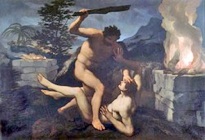
This panel, which is attributed to Andrea Camassei, forms part of the Collection of the Fondazione Cassa di Risparmio di Perugia.
Spello
Nativity (1648)
Taddeo Donnola, who was prior of San Lorenzo, commissioned this altarpiece for the church. It was removed from the Altare del Riscatto in the 1970s. [Where is it now?]
Flight into Egypt (17th century)
This altarpiece from San Lorenzo is attributed to Andrea Camassei on the basis of a signed engraving. [Raccolta Parrocchiale ?]
SS Bernardino of Siena and Antony of Padua (17th century)
